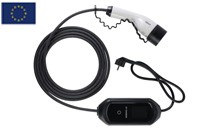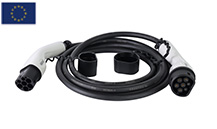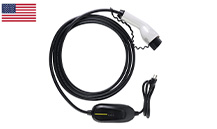The world is promoting low-carbon travel, driven by the goal of "double carbon", whether it is private cars, cabs, online vehicles, buses, forklifts, trucks, etc., there is a trend to gradually replace them with electric vehicles. Electric vehicles have gradually penetrated into every aspect of our lives and social production. EV relies on electric power to drive driving, and EV charging cable is an important part of EV and power charging connection, and one of the key components of EV conduction charging system. Charging cables are generally used in charging stations, parking lots, hotels, neighborhoods, garages and other areas, and portable charging cables can be placed directly in the car.
There are four main charging modes for EV charging.
Mode 1: The combination of single-head charging connector + cable + ordinary CEE plug connected to single-phase utility
Mode 2: The charging cable adds ICCB controller on the basis of mode 1, which has better protection than charging mode 1
Mode 3: Combination of double-headed charging connector + cable + charging post connected to single-phase power or three-phase power
Mode 4: Combination of charging connector + cable + DC (direct current) charging post
Are the charging cable specifications the same for different EV charging modes? No, they are not. We choose the cable mainly according to the output current size in different charging modes.
The current of charging mode 1 is 10A and 16A, corresponding cables are selected FAFA-E 3*1.5 square cable, FAFA-E 3*2.5 square cable.
charging mode 2 with rated current of 10A/16A, the recommended cable is FAFA-E 3*2.5+2*0.75, and rated current of 16A/32A, the recommended cable is FAFA-E 3*4.0+2*0.75.
The common output currents of charging mode 3 are single-phase 16A/32A, three-phase 32A, three-phase 63A, three-phase 125A, corresponding charging cables are optional FAFA-E 3*4.0+2*0.75 cable, FAFA-E 3*6.0+2*0.75 cable, FAFA-E 5*6.0+2*0.75 cable, FAFA-E 5*16+2* 0.75 cable, FAFA-E 5*35+2*0.75 cable.
Charging mode 4 is DC charging, the current flow is higher, so the charging speed is faster, of course, the performance requirements for the cable are also higher. The common output currents in this mode are 80A, 125A, 200A, 250A, and the corresponding charging cables are FAFA-E 2*20+25+2*4.0+6*0.75 cable, FAFA-E 2*35+25+2*4.0+6*0.75 cable, FAFA-E 2*50+25+2*4.0+6*0.75 cable, FAFA-E 2*50+25+2*4.0+6*0.75 cable, FAFA-E 2*50+25+2*4.0+6*0.75 cable, FAFA-E 2*50+25+2*4.0+6*0.75 cable, FAFA-E 2*50+25+2*4.0+6*0.75 cable. FAFA-E 2*80+25+2*4.0+6*0.75 cable.
No matter which charging mode, you need to choose EV charging cable with certification, which is not only safer, but also has product guarantee.
FAFA-E EV charging cable is flexible, soft to the touch, made of environmentally friendly and non-toxic materials, in compliance with RoHS and REACH latest environmental standards, with good acid and alkali resistance, aging resistance, chemical resistance, solvent resistance and other characteristics.






 简体中文
简体中文
